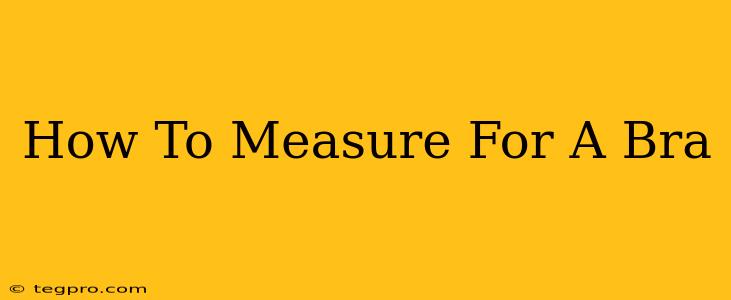Finding the perfect-fitting bra can feel like searching for the Holy Grail. An ill-fitting bra can lead to discomfort, back pain, and even affect your posture. But fear not! Learning how to accurately measure for a bra is easier than you think. This guide will walk you through the process, ensuring you're confident in finding your perfect fit.
Why Accurate Bra Measurement Matters
Before we dive into the how-to, let's understand why accurate measurement is so crucial. A properly fitting bra provides:
- Comfort: No more digging straps, pinching wires, or uncomfortable band tightness.
- Support: Proper support reduces back pain and improves posture.
- Shape: A well-fitting bra enhances your natural shape and provides a flattering silhouette under clothing.
- Confidence: Feeling good in your bra translates to increased confidence and self-esteem.
Measuring Your Bra Size: A Step-by-Step Guide
You'll need a soft tape measure and a mirror for this process. Remember to stand straight and relax your shoulders.
Step 1: Measuring Your Band Size
- Find your natural waistline: Place the tape measure around your ribcage, directly underneath your breasts.
- Measure snugly: The tape measure should be snug but not tight. You should be able to comfortably breathe.
- Note the measurement: Round up to the nearest even number. This is your band size. For example, if you measure 32 inches, your band size is 32.
Step 2: Measuring Your Bust Size
- Stand tall: Maintain good posture.
- Place the tape measure: Wrap the tape measure around the fullest part of your bust, ensuring it's level and comfortable.
- Take the measurement: Note this measurement. This is your bust size.
Step 3: Calculating Your Bra Size
-
Subtract your band size from your bust size: This gives you the cup size difference.
-
Interpret the difference:
- 0-1 inch difference: AA cup
- 1-2 inch difference: A cup
- 2-3 inch difference: B cup
- 3-4 inch difference: C cup
- 4-5 inch difference: D cup
- 5-6 inch difference: DD/E cup
- 6-7 inch difference: DDD/F cup
- 7+ inch difference: G cup and above
Example: If your band size is 32 inches and your bust size is 35 inches, the difference is 3 inches. This indicates a C cup. Therefore, your bra size is 32C.
Beyond the Numbers: Other Factors to Consider
While the above measurements are a great starting point, other factors influence bra fit:
- Band tightness: The band should provide most of the support. If it's too loose, the bra will ride up.
- Wire fit: The wire should lie flat against your ribcage, comfortably encasing your breast tissue. Avoid wires that dig or poke.
- Strap comfort: Straps should be adjustable and not dig into your shoulders. They should share the support with the band.
- Cup shape and coverage: Different bra styles offer varying levels of coverage and support. Experiment to find what works best for you.
- Breast shape: Breast shapes vary significantly. Consider different styles to find one that complements your shape.
Tips for Finding the Perfect Fit
- Try on multiple bras: Don't settle for the first one you try. Different brands and styles fit differently.
- Consult a bra fitter: Many department stores and lingerie shops offer professional bra fitting services. This can be invaluable if you're struggling to find your perfect fit.
- Read reviews: Online reviews can provide insight into how different bra styles and brands fit.
- Consider your lifestyle: Choose a bra style that's appropriate for your daily activities.
- Don't be afraid to experiment: Finding the right bra is a process. Be patient and persistent!
Finding the perfect bra is a journey, not a destination. By following these steps and considering the additional factors, you’ll be well on your way to finding a bra that fits comfortably, supports you properly, and makes you feel confident and amazing.

